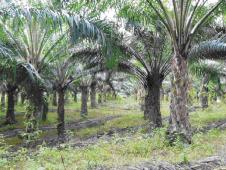
Sumatra’s lowland rainforests are being converted to oil palm plantations on a massive scale, affecting forest birds, Important Bird Areas and local communities. Concern for the ecological and social impacts of the palm oil industry has been very slow to develop among the international financial institutions that have helped to fund the industry’s growth worldwide, and among the multinational corporations that are the major buyers and consumers of palm oil as a raw commodity.
Sumatra is Indonesia’s largest island and one of the richest and most spectacular biodiversity hotspots on Earth. Yet Sumatra’s lowland rainforests are being converted to oil palm plantations on a massive scale. As a result, over 75% of Sumatra’s 102 lowland forest-dependent bird species are now considered to be threatened or Near Threatened with global extinction (BirdLife International 2004). Twenty-seven of Sumatra’s 34 Important Bird Areas (IBAs) contain major tracts of lowland rainforest, but more than 60% of this estate remains totally unprotected (Holmes and Rombang 2001).
Over 40,000 km² of Sumatran rainforest have been clear-cut during the past 20 years, with the lumber feeding the wood-pulp industry and the deforested land being turned over to the plantation industry, primarily for oil palm (Forest Watch Indonesia/Global Forest Watch 2002). Local communities have been displaced and social conflict has resulted (Casson 1999). The World Bank has warned that Sumatra’s remaining lowland rainforests will be gone by 2005 if current deforestation rates continue (Holmes 2000).
Palm oil is Indonesia’s most lucrative agricultural commodity, and global demand continues to increase (Casson 1999). Multinational corporations are major buyers, and use palm oil to make such everyday products as margarine, ice-cream, biscuits, crisps, chocolates, cooking oil, soaps, lipsticks, hand-creams and sun-creams (Matthew and van Gelder 2001).
There remains no effective mechanism for realising the global value of biodiversity in these irreplaceable forests. A national governmental focus on short-term economic benefits has been allowed to drive widespread rainforest logging and conversion in Indonesia (Forest Watch Indonesia/Global Forest Watch 2002, Casson 1999). Concern for the ecological and social impact of the palm oil industry has been very slow to develop among the international financial institutions that have helped to fund the industry’s growth worldwide, and among the multinational corporations that are the major buyers and consumers of palm oil as a raw commodity (Matthew and van Gelder 2001).
Related Case Studies in other sections
References
Compiled: 2004 Copyright: 2004
Recommended Citation:
BirdLife International (2004)
In current global markets, oil palm plantations are valued more highly than ancient forest.
Downloaded from https://datazone.birdlife.org/sowb/casestudy/in-current-global-markets-oil-palm-plantations-are-valued-more-highly-than-ancient-forest on 22/12/2024